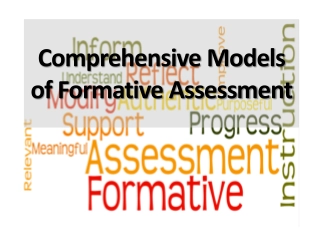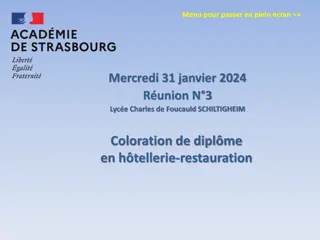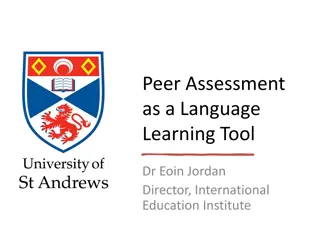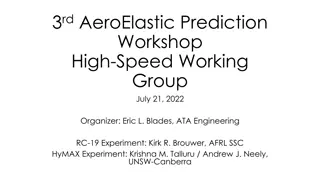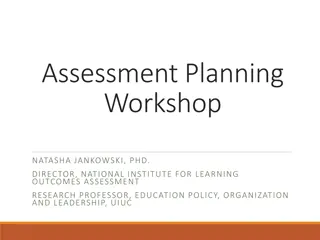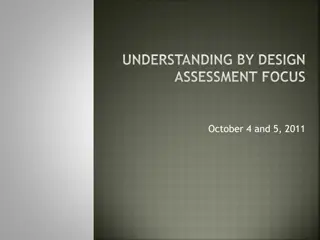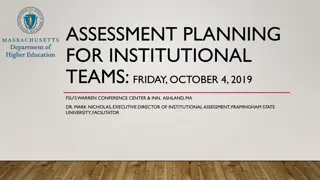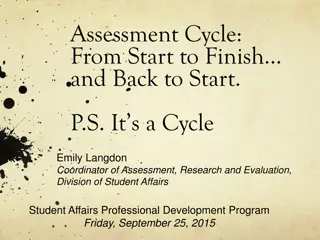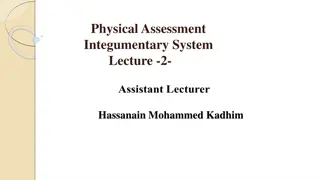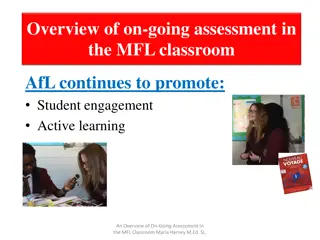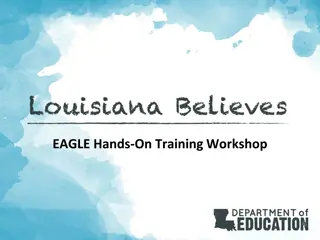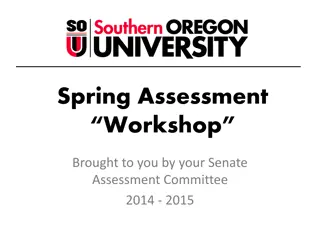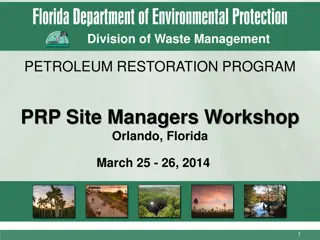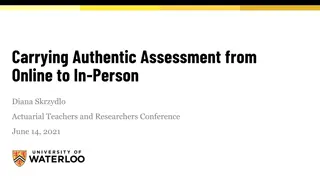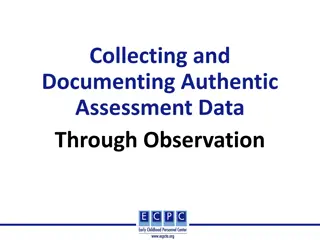Learning Assessment Techniques Workshop Overview
Explore the essentials of learning assessment techniques presented by Dr. Javier Cavazos Vela. Uncover the significance of LATs, benefits, and application across different learning domains. Delve into the concepts of backward design and its role in effective lesson planning, assessment, and student-centered learning experiences.
Download Presentation

Please find below an Image/Link to download the presentation.
The content on the website is provided AS IS for your information and personal use only. It may not be sold, licensed, or shared on other websites without obtaining consent from the author.If you encounter any issues during the download, it is possible that the publisher has removed the file from their server.
You are allowed to download the files provided on this website for personal or commercial use, subject to the condition that they are used lawfully. All files are the property of their respective owners.
The content on the website is provided AS IS for your information and personal use only. It may not be sold, licensed, or shared on other websites without obtaining consent from the author.
E N D
Presentation Transcript
Learning Assessment Techniques Javier Cavazos Vela, Ph.D. Director, Center for Teaching Excellence (CTE) Assistant Professor, College of Education and P-16 Integration
Learning Objectives After this interactive workshop, you will be able to: Identify important ideas and benefits of learning assessment techniques Recognize and apply several learning assessment techniques across Fink s (2013) taxonomy of learning Create a plan to implement what you learned
Learning Assessment Technique 1: Background Knowledge Probe for Foundational Knowledge Take 1-minute to write what you know about learning assessment techniques and backward design. We will call on two people to share and report out!
What is a Learning Assessment Technique? Three-part structure that helps teachers: Identify significant learning goals Implement effective learning activities (active learning) Produce an assessable learning artifact Formative vs. summative assessment Analyze and report outcomes
Why use LATs? Provides just-in-time feedback Provides information about student learning Provides students with opportunities to monitor their learning Helps students feel less anonymous in large classes Helps students understand that learning is an ongoing process (Center for Teaching Excellence, Vanderbilt University)
What is Backward Design? Backward Design is a process of lesson planning created by Grant Wiggins and Jay McTighe and introduced in Understanding by Design (1998). Backward design focuses on results-based, student-centered learning Backward Design Topics Assessments Activities Identify desired results Traditional Determine assessment activities Wiggins, G & McTighe, J. (1998). Understanding by Design. Alexandria, VA: Association for Supervision and Curriculum Development. Plan learning experiences and Instruction
Why use Backward Design? Focuses on student learning and understanding Encourages instructor to establish purpose before implementation Leads to transparent and explicit instruction
Finks Taxonomy of Learning Objectives Foundational Knowledge (identify, describe) Application (apply, demonstrate, practice) Integration (combine, compare, evaluate) Human Dimension (reflect, relate) Caring (reflect, appraise, collaborate) Learning how to Learn (reflect, collaborate, write)
Foundational Knowledge Refers to discipline facts, principles, and concepts; lays groundwork for future learning Important questions to address: What information is important for students to remember in the future? What ideas are important for students to remember in this course? Key verbs: identify, recognize, define, describe, and summarize Sample LATs: background knowledge probe, entry ticket, exit ticket, minute paper, quick write, and guided reading notes
Learning Assessment Technique 1: Background Knowledge Probe for Foundational Knowledge Learning goals: knowledge of key facts and ideas Description: simple questionnaire that asks students to identify prior knowledge Purpose: encourages students to think about what they already know about a topic
Learning Assessment Activity 2: Quick Write or Minute Paper Learning Goals: foundational knowledge Description: students write responses to an open-ended question Purpose: forces students to focus and recall information
Learning Assessment Activity 2: Quick Write or Minute Paper Take 1-minute to write what you recall about Fink s taxonomy of learning dimensions We will call on two people to share and report out!
Application Refers to applying knowledge through skills, learning how to manage complex projects, and developing ability to engage in critical, creative, and practical thinking Important questions to consider: what skills do students need to learn? What kinds of thinking are important for students to learn? Key verbs: Apply, evaluate, formulate, plan, prepare, use, synthesize Sample LATs: fact or opinion and Insights-Resources-Application
Learning Assessment Technique 4: Fact or Opinion Learning Goals: application (critical thinking, reading) Description: students read a text to identify authors facts or opinions Purpose: fosters critical thinking and active learning
Learning Assessment Activity 5: Insights- Resource-Application Learning Goals: analytical skills, creative thinking, critical thinking, research skills (Application) Description: students complete a writing assignment based on assigned readings Purpose: provides students with an opportunity to reflect on what they learned and apply what they learn to previous or current experiences Insights: provide one sentence that represent new insights about today s topic Resource: provide one additional source that has similar thoughts, ideas, or themes Application: how is what you learned today related to your current or past experiences?
Integration Refers to when learners integrate, connect, and relate various concepts and ideas together Important questions to consider: What connections should students make in this course among various information, ideas, and perspectives? What connections should students make between previous and current learning experiences? Key verbs: incorporate, organize, synthesize, compare, contrast, combine Sample LAT: case study
Learning Assessment Activity 6: Case Study Learning Goals: connect and synthesize to think holistically about a topic Description: Tells a real story about an important issue related to course content Includes historical information about the case and a dilemma faced by a key character Encourages students to identify a problem as well as take and support a solution Encourages students to integrate information and resolve an issue (Davis, 1993)
Human Dimension Refers to important relationships and interactions we all have with ourselves and with others (Fink, 2013, p. 50). Important questions to address: What should students learn about themselves? What should students learn about interacting with others? Key verbs: reflect, support, help, communicate Sample LATs: role play, ethical dilemma
Rubric for Evaluating Peer Support and Interpersonal Skills
Learning How to Learn Refers to when students learn about the process of learning or become self-directed learners Key verbs: reflect, identify, organize, and write Sample LATs: study outlines, invent the quiz, what? So what? Now what? Journal
Learning Assessment Technique 7: What? So What? Now What? Journal Learning goals: Learning how to learn Purpose: determine if students are able to reflect on what they learn and apply what they learned to develop a plan Description: Students reflect and write responses to the following questions. A total of 5 sentences will be sufficient if they address each question. What? (1) What happened in today s session? So What? (2) What did you learn today? (3) What connections can you make between what you learned today and previous learning experiences? Now What? (4) How can you apply what you learned? (5) What would you like to learn more about and how will you learn more about this or a similar topic?
Final Remarks Thank you for participating in this interactive workshop where we hope you met session objectives and developed a plan to implement learning assessment techniques. Please complete evaluation questions about your learning experiences and level of satisfaction. Please also take a look at resources on our website utrgv.edu/cte which will provide helpful and additional information.
References and Helpful Resources Barkley, E. F., & Major, C. H. (2016). Learning assessment techniques: A handbook for college faculty. San Francisco, CA: John Wiley & Sons, Inc. Center for Teaching Excellence, Vanderbilt University (2017). Retrieved from https://cft.vanderbilt.edu/


